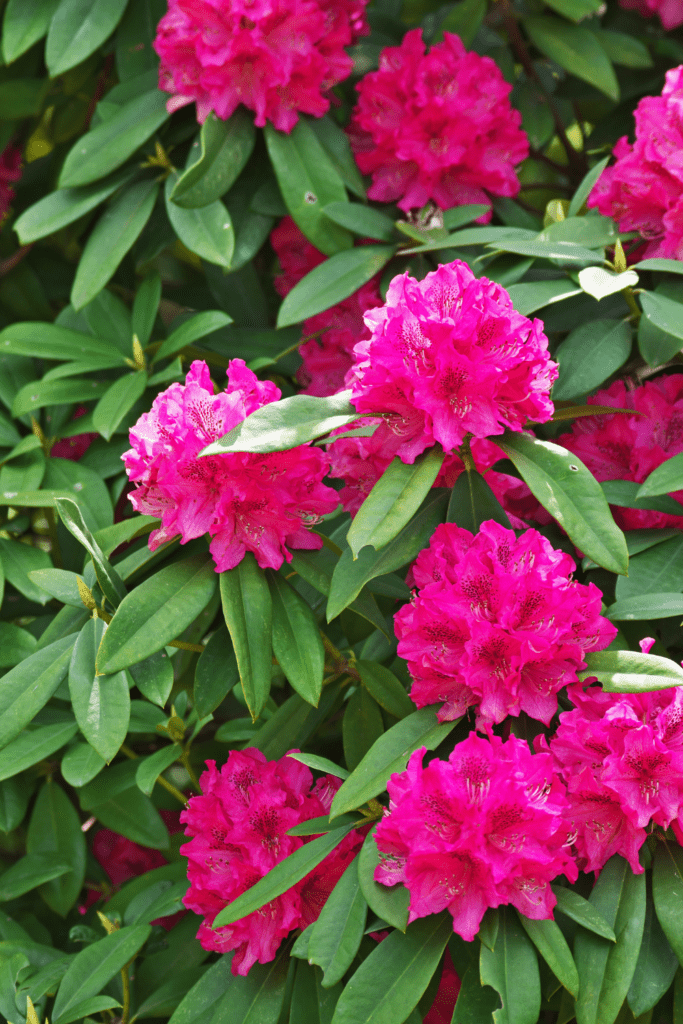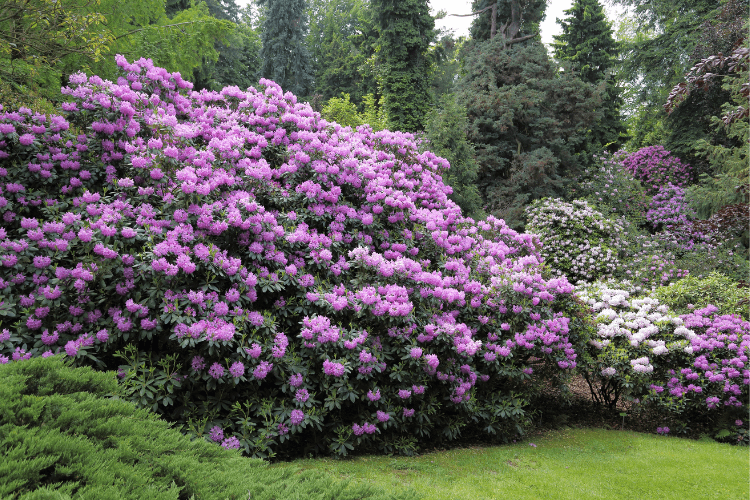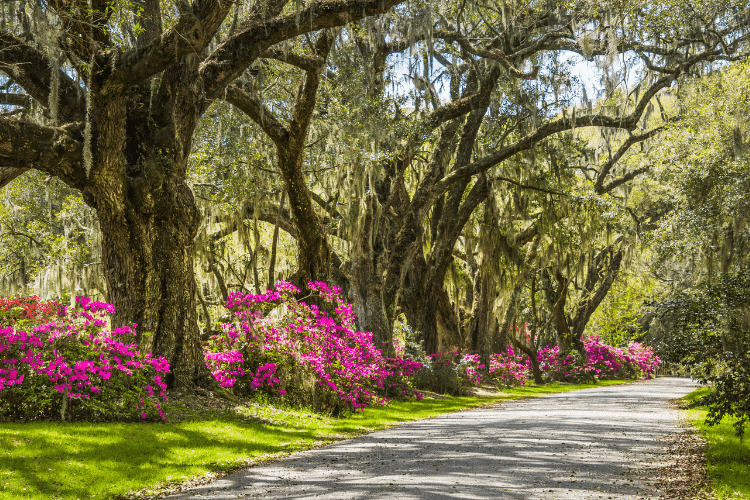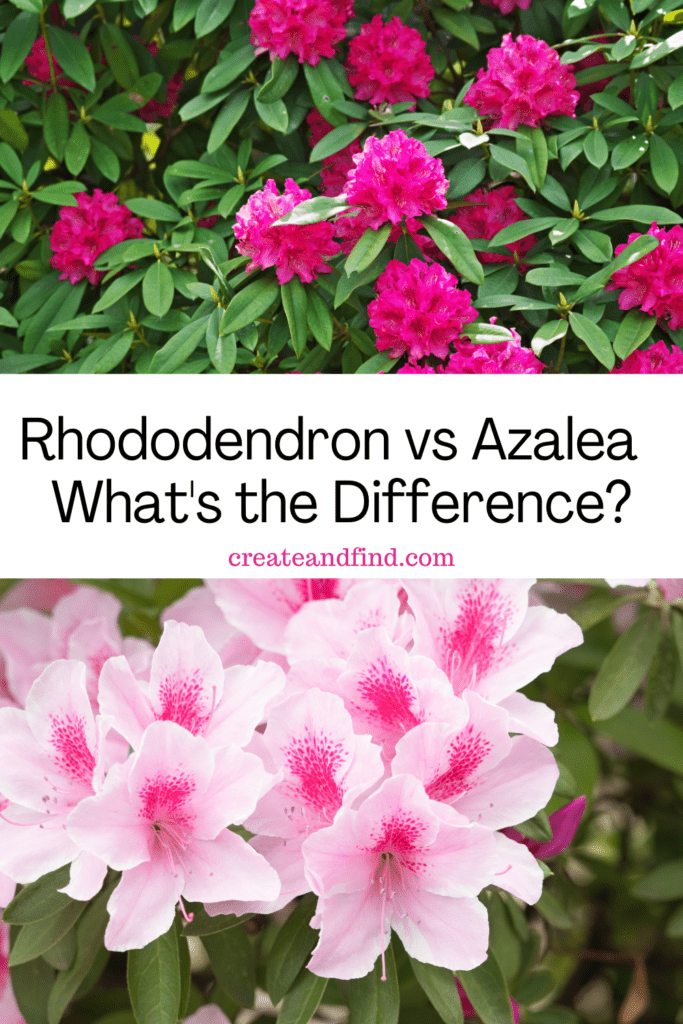Rhododendron vs. Azalea has many people confused about whether these plants are the same or two separate species.
Due to many shared characteristics, Azaleas and Rhododendrons fall into the same genus classification. But they are not the same plant. Instead, they are two varieties of ornamental shrubs that produce vibrant colors from spring to summer. Keep reading to find out more about the Azalea and the rhododendron plants.
Are Rhododendron and Azaleas the same plant?
Azaleas and Rhododendron plants both fall under the Rhododendron genus. There are over 900 species and more than 20,000 hybrids. But the two plants used to fall into two separate groups.
These two species are close relatives but are not the same plant. Because Azaleas fall into the Rhododendron genus, all Azaleas are Rhododendron species. However, not all Rhododendron plants are Azaleas.
Planting Zones for Rhododendron
Rhododendron plants grow in USDA hardiness zones 4 through 10. These plants have better cold hardiness than Azaleas but are fussier.
They do best in climates that aren’t too cold but also aren’t too hot. Areas, where they thrive the most, include Northern California, the upper areas of the South, and the Northwest, including the Pacific Northwest.
Planting Zones for Azalea
Azalea plants are easy to grow in zones 6 to 8 as perennials. But they can be hardy in zones 7 through 9. When planted below zone 7, your Azaleas will require different care to keep them protected through winter.
They do best in the humid, hot, and wet climates found in the South, primarily the Coastal and Deep south.
What are the Main Differences – Rhododendron vs Azalea?
Azaleas can be evergreen or deciduous plants that grow between 1 and 2 feet tall, with hairy, soft, thin leaves and small stems with one to three flowers.
Azalea flowers have 5 to 6 stamens that hang out of the center of the funnel tube shape. Azaleas also have a higher risk of getting diseases and bloom in the early spring.
Rhododendrons are typically evergreen, although there are some deciduous options. All of the species produce flowers in late spring. Evergreen species have thick, leathery large leaves, with some having tiny dots – scales – on the bottom.
These larger bushes can reach 20 feet wide, with fewer thick stems and bell-shaped flowers in trusses – large clusters – with each flower having ten stamens or more.
The color of the flowers is also different between Azalea and Rhododendron plants. Azaleas come in lavender, white, yellow, purple, pink, red, orange, and lavender. But rhododendrons come in fewer colors of purple, white, red, orchid pink, and occasionally yellow.

Where is the Best Place to Plant Rhododendron?
Rhododendrons require organic, fertile, acidic, moist, well-draining soil. Unfortunately, your plants can’t handle wet dirt or periods of drought. However, these plants can grow year-round in warm climates and do best when you add compost around the hole before planting.
Your plants also require a sheltered planting location that will provide dappled shade. But don’t choose a site of deep shade beneath larger trees. You can have open planting sites in dry, cold winds, given your plants have protection to avoid the stem bark from splitting or leaf scorches.

Where is the Best Place to Plant Azaleas?
Azaleas require humus-rich soil – slightly acidic – and well-drained so the plants get enough nutrients. The roots grow close to the surface; regular heavy mulching can prevent the plants from drying out.
These plants are easy to care for, with little to no fertilizer. And they are at less risk of diseases and pests. You can plant your Azaleas near hedges or in medium or large gardens.
Sunlight Requirements for Rhododendron vs Azalea
Rhododendrons and Azaleas require partial sun exposure for adequate growth. Therefore, they do best in dappled shade – or a sunny area where they can get at least a few hours of shade.
Full sun can cause damage to the flowers and leaves, especially those that produce white blooms. Deep shade – especially under large trees – is also unsuitable, as the plants won’t get enough sunlight to thrive.
In colder zones 3 through 6, your flowers need a fully sunny spot where they can get six hours or more of sunlight daily. They also need a sheltered area from wind, which can cause the buds and leaves to dry out in winter winds.
Afternoon shade is better in hot areas in zones 7 through 11. But in tropical climates, you can get azaleas to bloom in full shade.

Water Requirements for Rhododendron vs Azalea
Rhododendrons and Azaleas have average but managed water needs. The shallow roots of the Azalea require uniform moistness to keep them from drying out but also prevent the roots from becoming soggy and rotted.
Give established plants ¾” to 1” of water on a regular schedule of 10 to 14 days when you’re going through dry periods. The soil should be moist 10” to 12” deep.
For newly planted Azaleas that grow in sandy soil, provide watering twice weekly during dry seasons until the plants are established.
However, if your area gets normal rain amounts, you won’t need to provide watering to your outdoor plants.
In the winter, provide deep waterings to rhododendron plants if there are warm days after cold periods. Dry, cold winds can cause the leaf moisture to evaporate, resulting in leaves that wither and die.
Does Rhododendron or Azalea need a Fertilizer?
Both Rhododendrons, and therefore Azaleas, do best in soil with low nutrients. Therefore, there is little need for you to use fertilizer, as it could cause damage to the delicate roots.
If you have to fertilize, choose an acidic fertilizer and apply the solution to the surface of the plants according to the manufacturer’s directions.
Fertilization should happen in the spring – no later than midsummer -before adding the heavy layer of mulch to keep the soil moisturized and reduce winter damage.

Azalea vs. Rhododendron Comparison
The Rhododendron genus contains the Rhododendron flower and the Azalea plant. All Azaleas classify as Rhododendrons, although not all Rhododendron plants classify as Azaleas. The flower shape, formation, plant size, and flower color are factors that vary by species.
Either way you go, you can’t go wrong with these gorgeous flowering plants. They make a striking landscape addition whether planted alone, in a hedge, or in a grouping.
And for more gorgeous shrub ideas, check out these low-maintenance shrubs or gorgeous flowering shrubs!



